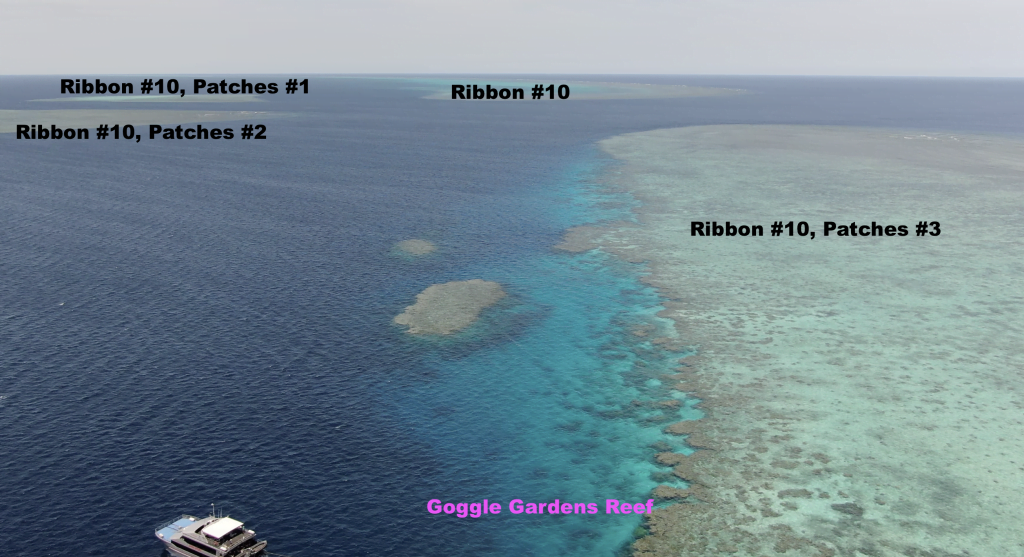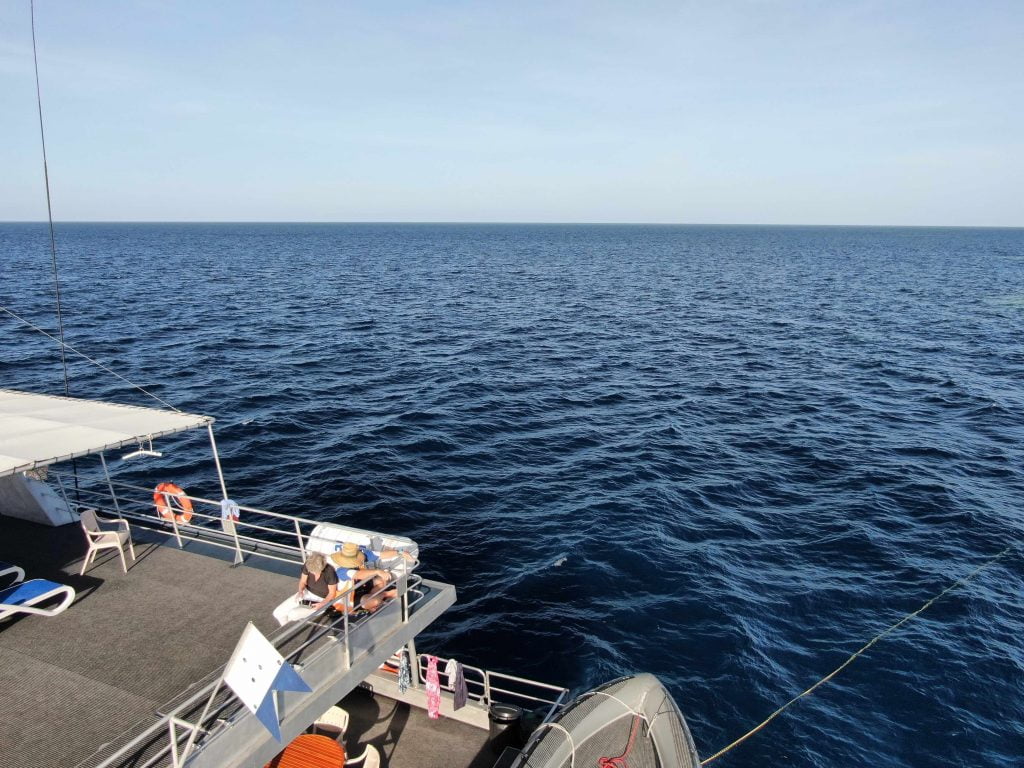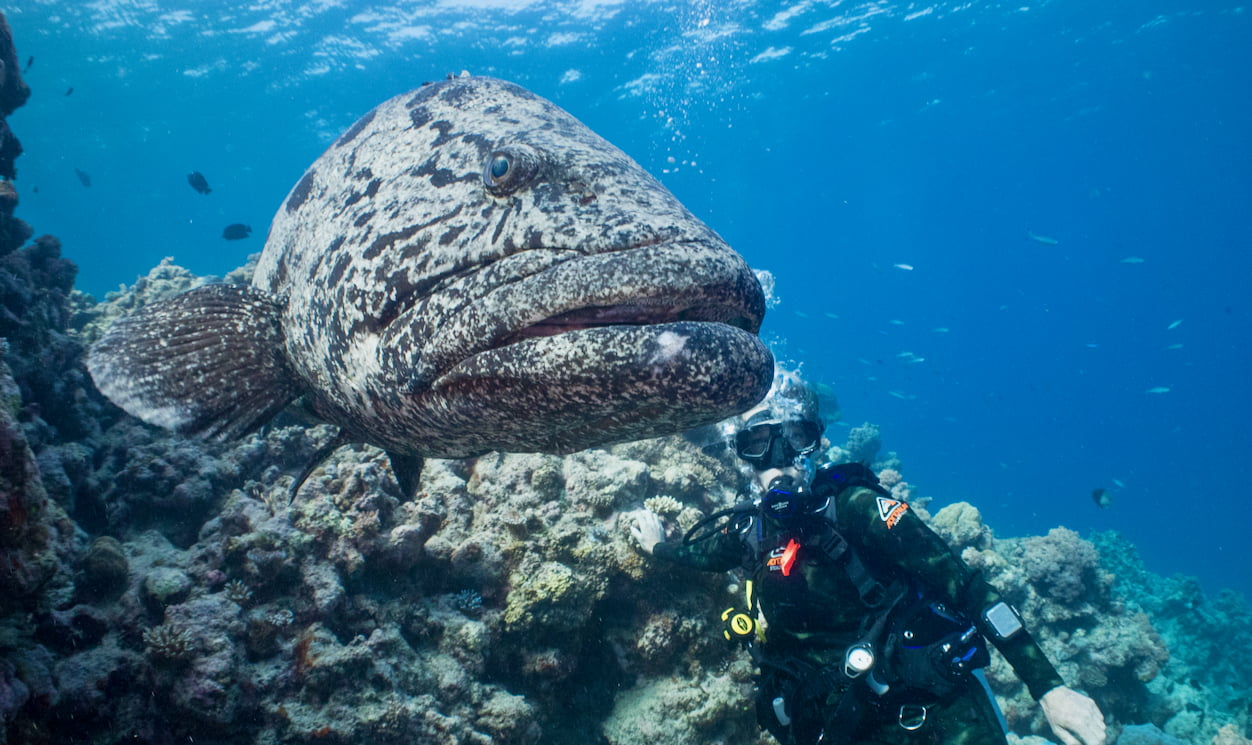Being able to sink below the waves at the edge of Australia’s continental shelf with the reef sharks and the colourful corals, is a rare privilege that I enjoyed just last week. It is possible because Jacques Cousteau invented the aqualung in 1942 providing a system for breathing and swimming safely at depth.
Ribbon Reef No. 10 is the longest of these most northern outer barriers with an inside (westerly-facing) edge that drops to 40 metres and an outside (easterly-facing) edge that drops vertically to 2,000 metres. This Ribbon also has what are called ‘Patches’, as shown in the screen shot from drone footage.
At the southern tip of this ribbon is an opening that was once where the Starke River entered the sea; that was more than 16,000 years ago when sea levels were up to 120 metres lower than they are today. This opening is between Ribbon No. 10 and Ribbon No. 10, Patches No. 3.

That river canyon is now underwater with strong currents, that wash in nutrient rich upwelling from the Pacific Ocean twice a day. The water rushes in, and then out. So I was pleased that there was a lookout on the top deck of our boat the entire time I was diving, with a tender handy, should I come up in a current that I couldn’t kick against and needed to be picked up. In fact, I always surfaced at the stairs to the boat, thanks to the great navigation skills of my underwater buddy.

On the sheltered side of Ribbon No. 10, Patches No. 3, is the dive site known as Goggle Gardens. The corals here are at 15 metres and were totally bleached white from March to October 2016.
What I learnt from a diver and her photographs is that white and bleached coral is not necessarily dead coral. The zooxanthellae — unicellular algae that give coral its colours and normally feeds it with energy from the sun via photosynthesis — were expelled, as the corals were stressed by the exceptionally warm waters during the summer of 2015 – 2016.
But the corals at this dive site did not die.
Coral polyps also have tentacles, and these tentacles were used to feed on small animals and plankton and also to clean away bad algae that would otherwise settle and smother it.
So, corals are not necessarily totally dependent on zooxanthellae, they can be omnivorous.
In fact, bleached coral can take-back zooxanthellae, become colourful again, and reshoot after months of being stark white and bleached.
I hope to show how this happened at this dive site in my next mini-documentary.
I’ve even been told, and may be able to get footage, of bleached corals spawning!
My buddy and underwater photographer dived this site three times last week, and we have so much footage. If you want to know exactly when this film will be released, then consider subscribing for my irregular e-newsletters.

*********
The feature image at the very top of this post is me with a large and friendly Potato cod, taken at one of the Ribbon reefs in January 2020.
UPDATE 10TH FEBRUARY 2020:
The map has been replaced from the original posting, I had incorrectly referred to Patches No. 3 as Ribbon No. 11. There is no Ribbon No. 11.


 Jennifer Marohasy BSc PhD is a critical thinker with expertise in the scientific method.
Jennifer Marohasy BSc PhD is a critical thinker with expertise in the scientific method.

What! You mean Peter was right all along? I’d expect we’ll see many more coral blooms while waiting on the public apology and announcement of reinstatement from JCU..
Thank you Jennifer. You’ve taught a couple of things about the reef l didn’t know. Appreciate very much what you are doing.
Cheers
Mike
Well, well, well… fancy that! (Well done Jen!) 😁👏
Thank you Jennifer. I look forward to your new documentary.
Thanks Jennifer for your tireless effort to keep the world informed of the truth of the matter on what looks to me like a very healthy GBR.
Can’t wait to see your new film as I’m using your output to help some people I know whose scant knowledge of the ‘dying’ reef get ‘re-educated’ in the facts that ‘they’ve only ever learnt via school in the last twenty years.
Thank you so much Jennifer for showing us that, despite what we’re constantly being told, the reef is in fact in fine shape. Looking forward to seeing your next film.
WOW!!!
Beautiful Photos of our reef in full bloom,
Thank you Jennifer
Jennifer you are a true scientist – going where the evidence takes you rather that looking only for “facts” that support a pre-determined narrative. You are greatly appreciated for this.
Frank
Dear Jennifer,
Thank you for your email . I greatly enjoy your posts and I think the work you do is very important. However , it is so tragic for science and for our country and the world that courageous scientists who speak out are ostracized and denied funding and support. As taxpayers we have paid $500 million to preserve the reef but no support from this money goes to anyone that does not ” toe the line” and espouse politically correct views. Some day we can hope this will change and the courage and truth of your scientific work will be more widely acknowledged. Keep up the good work .
Just filing this here:
Potato cod and reef sharks attaching a unicorn fish at the Cod Hole.
Jen, thanks and congratulations for your continuing “audit” of the GBR which is showing us that it is not as bad as we have been told by “experts”.
That there is another side to the story.
Just as there is with temperatures and sea levels.
Thanks Jen for all your work and commitment to researching he Great Barrier Reef.
It wonderfull to see it is in robust good health despite all our worriters efforts to make us think it destroyed and lost for ever.
Great video !
Loved the video. Those gentle giants have a mean streak or maybe they were just hungry. Why are the other fish left alone?
What I have learned so far is that James Cook could be shut down entirely and we could just ask Peter and yourself for the facts. I wonder do the bought and paid for scientists ever feel embarrassed; they should. Have you ever contacted the Minister, Dan Tehan, with your findings. He might be surprised at the difference with the JCU findings. He might also be concerned that all that money is being wasted. He might be concerned at the public’s reaction to the truth.
Hi Jennifer,
Thanks for recent blog, you make my day !!
Cheers. Michael Tarbuck
Interesting that bit about massive falls in sea levels no doubt corresponding with ice age component periods. How does the coral regenerate? Maybe that’s a Q for Peter Ridd
Hi Jen,
Wow, great photos. Thank you for posting such beautiful photos of the reef.
I love your posts and photos as I will probably never get to see that for myself as many others wont either and you keep us so informed and up to date its a pleasure to read about your experiences. much appreciated, thank you Jen.
It is sobering to realise that during the last ice age (ca 16,000 years ago) the inner edge of your dive site was dry land, and that the aboriginal inhabitants of that time probably lived on the coast and estuaries right where you are.
As the average global temperature at that time is thought to be 10 deg C lower than today there would have been old campfires along the shoreline. Now they would be coral encrusted and probably totally unrecognisable.
And this is a significant issue for modern Archaeology- much of the evidence of older human habitation is along old ice-age shorelines, now at ~120m below current sea level.
Great work and of a truly realistic nature that provides factual evidence raher than suppositions of catastrophe.
Keep up the good work
Jennifer. You were mentioned in derogatory terms last night on the ABC Media Watch.
They (and most climate alarmists) continue to denigrate us as ‘deniers of climate change’.
They have never explained what they say we are ‘denying’.
Jennifer – As Churchill said, never, never, never give up.
*********
Thanks John, You have inspired my response here: https://jennifermarohasy.com/2020/02/cooling-the-past-made-easy-for-paul-barry/